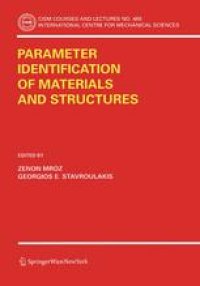
Ebook: Parameter Identification of Materials and Structures
- Tags: Numerical and Computational Methods in Engineering, Computer Applications in Geosciences, Calculus of Variations and Optimal Control, Optimization, Artificial Intelligence (incl. Robotics)
- Series: CISM International Centre for Mechanical Sciences 469
- Year: 2005
- Publisher: Springer-Verlag Wien
- Edition: 1
- Language: English
- pdf
The nature and the human creations are full of complex phenomena, which sometimes can be observed but rarely follow our hypotheses. The best we can do is to build a parametric model and then try to adjust the unknown parameters based on the available observations. This topic, called parameter identification, is discussed in this book for materials and structures. The present volume of lecture notes follows a very successful advanced school, which we had the honor to coordinate in Udine, October 6-10, 2003. The authors of this volume present a wide spectrum of theories, methods and applications related to inverse and parameter identification problems. We thank the invited lecturers and the authors of this book for their contributions, the participants of the course for their active participation and the interesting discussions as well as the people of CISMfor their hospitality and their well-known professional help. Zenon Mroz Georgios E. Stavroulakis CONTENTS Preface An overview of enhanced modal identification by L. Bolognini 1 The reciprocity gap functional for identifying defects and cracks by H. D. Bui, A. Constantinescu and H. Maigre 17 Some innovative industrial prospects centered on inverse analyses by G. Maier, M. Bocciarelli andR. Fedele 55 Identification of damage in beam and plate structures using parameter dependent modal changes and thermographic methods by Z. Mroz andK. Dems 95 Crack and flaw identification in statics and dynamics, using filter algorithms and soft computing by G. E, Stavroulakis, M. Engelhardt andH.
The nature and the human creations are full of complex phenomena, which sometimes can be observed but rarely follow our hypotheses. The best we can do is to build a parametric model and try to adjust (identify) the unknown parameters based on the available observations. The authors discuss problems relevant to materials and structures like inverse analysis in structures, crack, material parameter and damage identification, modal analysis and thermographic methods. The solution methods vary from classical optimization to neural networks and genetic algorithms. Since all the authors are engineers, well-known in the academic and industrial world, the emphasis is posed on methods which really work. In fact, the chapters provide state-of-the-art information supplemented by selected examples and numerous references to modern publications, so that the reader can directly proceed with the study of his own problems.